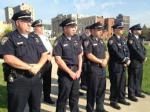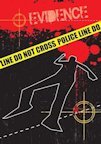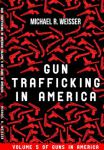As is expected, whenever any research is published that raises the issue of risks from guns, we can usually count on John Lott to set the record straight. By which I mean he will concoct a response that will inform us about the values and virtues of citizens walking around with guns. And whether he publishes it under his own name or engages in a bit of journalistic identity theft to send it out as if it were allegedly written by someone else, the message is always the same, namely, the more guns that are bought, owned and used, the more we all are protected from violence and crime.
 In this week’s episode, Lott not only promotes the idea that ordinary citizens are more safe because we own so many guns, he’s also trying to convince us that law enforcement officers are also safer because civilians own and carry guns. What got him onto this kick was a new piece of public health research which examined the connection, if any, between levels of gun ownership in various states and homicide rates of police, those homicides defined as death from an assault, so as to distinguish such events from other ways in which police lose their lives on the job, primarily from cracking up their cars.
In this week’s episode, Lott not only promotes the idea that ordinary citizens are more safe because we own so many guns, he’s also trying to convince us that law enforcement officers are also safer because civilians own and carry guns. What got him onto this kick was a new piece of public health research which examined the connection, if any, between levels of gun ownership in various states and homicide rates of police, those homicides defined as death from an assault, so as to distinguish such events from other ways in which police lose their lives on the job, primarily from cracking up their cars.
It turns out that police working in what are referred to as “high” gun states where a majority of the homes contain guns, experience three times the rate of felonious death as cops working in what’s called “low” gun states, where household gun ownership is under 20%. More than 90% of all cops who are murdered on the job are assaulted with a gun. In making the connection between LE felony deaths and gun ownership, the researchers used standard regression variables (crime rate, income, % minority residents, etc.) but found that the data showed a consistent pattern: more guns, more cops shot with guns.
Lott begins his critique of this research by accusing the authors of leaving out data controls “used by everyone else for this type of empirical work.” The ’everyone’ in this case happens to be one person named John Lott, who then goes on to explain that using a different analytical model would have allowed the researchers to “more accurately explain for differences in crime rates across states or over time.” Except the article doesn’t talk about crime rates; it talks only about whether more cops get shot in states where there are more guns.
Lott’s attempt to discredit this research hits a new low, even for him, when he accuses the authors of presenting data on gun ownership when, in fact, the data they used covered gun suicides whose frequency, when associated with LE gun deaths, would show fewer cop homicides as the number of suicides increased. But the researchers made it clear they were using gun suicide data as a proxy, i.e., a well-established statistical method for estimating the value of any variable (in this case, gun ownership) when category-specific data is either incomplete or doesn’t exist.
What’s really on Lott’s agenda, of course, has nothing to do with whether more cops get killed in places where there are more guns. As the self-appointed Chief Clerk of the American Gun Arsenal, what Lott wants is for everyone to own a gun. As he says, “There are lots of good law-abiding citizens who not only protect themselves and their fellow citizens, but even help protect the police.”
I am convinced that John Lott lives in a self-constructed dream world, but I have an idea that might wake him up. I really hope that someone accidentally shoots a cop with a gun they are carrying around to protect the police; not a serious wound, mind you, just a little scratch. And when they plead to attempted murder or maybe just aggravated assault, I hope they’ll ask John Lott to appear on their behalf as an expert witness so that he can explain to the Court why everyone should be walking around with a gun.



Recent Comments